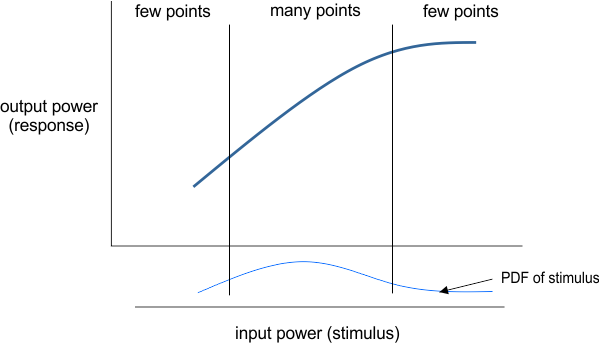Choosing the Time Length
There is no correct time length for stimulus-response measurements. In general, the more points you have, the more accurate your measurement will be. The number of points you need depends on the characteristics of your stimulus signal (essentially the PDF 1) Probability Density Function Trace Data, or 2) Portable Document Format (PDF) created by Adobe Systems is an open standard for document exchange., which determines the probability of the stimulus voltage, which then determines the distribution of points along the stimulus-response curve).
For example, in the illustration below, the PDF of the stimulus signal is such that the middle of the stimulus-response curve is covered with more points than either end of the curve. In this case, to increase the number of points at either end of the curve, you can either change the average power of the stimulus signal (shifting the PDF to the right to cover the upper part of the curve) or you can just increase the number of points acquired from the measurement hardware.

A good rule of thumb for choosing the number of points is to capture as many as possible, taking into account that more points means longer acquisition and measurement times.
The number of points that the VSA captures cannot be specified directly. Instead you will want to specify the time length to acquire. The Graph traces use a certain number of points for time alignment and phase compensation (filter settling) that depends on the respective compensation settings so you will need to acquire slightly more points than you want.
The smaller the span, the longer time record you will need to get the same number of points (because there is more time between each sample point).
Other things to consider
When you are using different instruments to measure stimulus and response signals, longer time lengths also means that there will be more frequency drift between the two instruments. Connecting the frequency reference between the two instruments will reduce this source of error.
When you are using a repeating stimulus signal, make sure the alignment width is shorter than the repetition period to minimize the chance of an incorrect time alignment.
See Also
